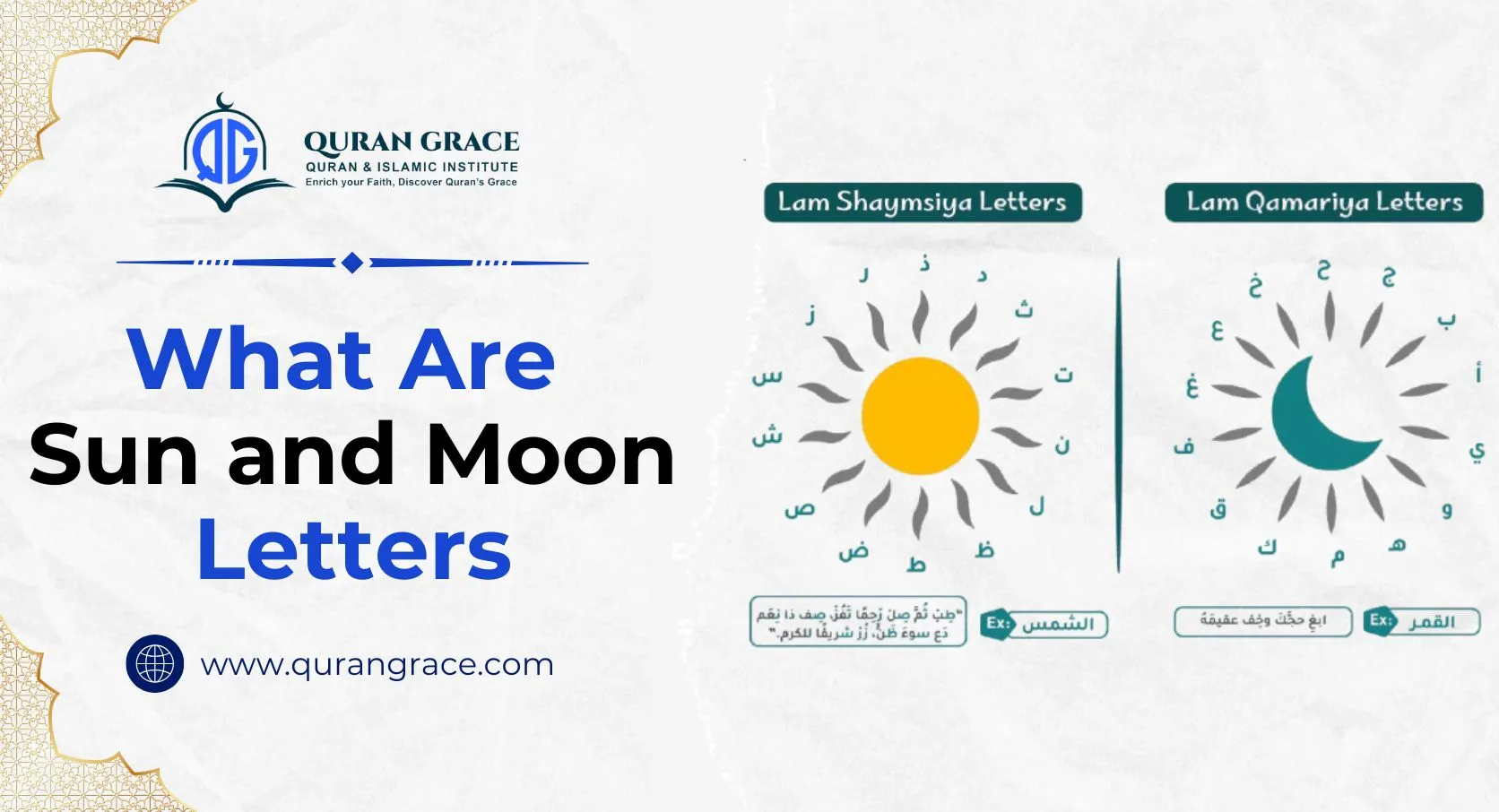In Arabic grammar, the terms “sun letters” and “moon letters” refer to specific categories that influence the pronunciation of the definite article “al” (ال). Moon letters are relatively straightforward, as they do not affect the pronunciation of ل; it is pronounced clearly when followed by a moon letter. In contrast, sun letters modify the pronunciation of ل, rendering it silent when it precedes a sun letter. Therefore, it’s essential to pay special attention to the sun letters. This exploration of Arabic grammar presents an opportunity to delve into the intricacies of these fascinating rules.
Table of Contents
ToggleSun and Moon Letters in Arabic
The terms “Sun letters” and “Moon letters” refer to specific rules in Arabic grammar that describe how certain letters interact with the Arabic definite article “al” (ال). The Arabic alphabet is categorized into two groups: Sun letters (حروف شمسية) and Moon letters (حروف قمرية). This classification is based on the pronunciation of the letter “ل” (lam) when it precedes certain consonants. Understanding the distinction between these two categories is essential for mastering pronunciation and grammar in Arabic. Let’s delve into these rules for a clearer understanding!
Examples:
- Sun letter: The sun is called الشَّمْس (ash-shams) in Arabic. Here, the “L” in “Al” is silent, and the “Sh” sound is doubled. We will not say Al-Shams.
- Moon letter: The moon is called القَمَر (al-qamar) in Arabic. In this case, the “L” in “Al” is pronounced clearly. We will not say Aq-Qamar.
The List of Sun and Moon Letters
Now, let’s get specific. Here is a list of sun and moon letters in Arabic with pronunciation:
Sun Letters (حروف شمسية):
- ت (Ta)
- ث (Tha)
- د (Dal)
- ذ (Dhal)
- ر (Ra)
- ز (Zay)
- س (Sin)
- ش (Shin)
- ص (Sad)
- ض (Dad)
- ط (Ta)
- ظ (Zha)
- ل (Lam)
- ن (Nun)
Moon Letters (حروف قمرية):
- أ (Alif)
- ب (Ba)
- ج (Jeem)
- ح (Ha)
- خ (Kha)
- ع (Ayn)
- غ (Ghayn)
- ف (Fa)
- ق (Qaf)
- ك (Kaf)
- م (Meem)
- ه (Ha)
- و (Waw)
- ي (Ya)
Why are They Called Sun letters?
In Arabic phonetics, when the letter “lam” comes before a sun letter, it is not pronounced. This is exemplified in the word “الشّمس” (al-shams), which is articulated as “ash-shams.” The sun letters, also known as “solar letters,” exhibit a unique feature: when they appear at the beginning of a word, they are doubled, indicated by a Shaddah. This doubling signifies their strength and prominence, making them similar to the sun.
Words Start With Sun Letters
| Example | Pronunciation Guide |
| الطّائر | al-taa’ir |
| الرّجل | ar-rajul |
| السّماء | as-samā’ |
| الشّمس | ash-shams |
| اللّغة | al-lughah |
Why are They Called Moon Letters?
In Arabic phonetics, when the letter “lam” precedes a moon letter, it is pronounced clearly. For example, the word “القمر” (al-qamar) is articulated as “al-qamar.” Moon letters, known as “lunar letters,” have the characteristic that when they begin a word, they are not doubled (they lack a Shaddah). This distinction symbolizes the softness and tranquility associated with the moon.
Words Start With Moon Letters
| Example | Pronunciation Guide |
| البْيت | al-bayt |
| الجمل | al-jamal |
| الماء | al-maa’ |
| الكتاب | al-kitaab |
| الورد | al-waraḍ |
How to Remember The Sun and Moon Letters?
Here are some steps to help you remember the sun and moon letters:
-
Visual Imagery
To enhance memory retention, visualize the two categories of letters. For sun letters, picture the sun (شمس) shining brightly over the respective letters that adhere to this rule. In contrast, for moon letters, envision the moon (قمر) softly illuminating the letters associated with this group.
-
Word Association
Strengthen your grasp of sun and moon letters by associating them with relevant words. For instance, think of “شمس” (sun) and “سحلية” (lizard) for sun letters, while for moon letters, consider words like “قمر” (moon) and “قلب” (heart). This association technique can aid in recalling the letters.
-
Color Coding
Utilizing color can be an effective mnemonic device. Assign a specific color to sun letters and a different one to moon letters. This visual differentiation can help enhance memorization and recognition.
-
Interactive Learning Tools
Employ flashcards, mobile apps, or online resources that are specifically designed to support learning Arabic grammar rules. Many of these tools offer engaging exercises and quizzes, making the learning process more interactive and enjoyable.
Why is it Important to Understand the Sun and Moon Letters?
The significance of Sun and Moon letters in Arabic cannot be overstated, as they play a crucial role in pronunciation, sentence structure, and vocabulary usage. Understanding these letters is vital for several reasons:
1. Pronunciation
Sun letters and Moon letters are pronounced differently, and learners need to grasp this distinction to articulate words correctly.
2. Grammar
These letters also impact the grammatical structure of Arabic sentences, influencing how they are formed and understood.
3. Vocabulary
Knowing about Sun and Moon letters can aid learners in broadening their vocabulary. By recognizing the patterns associated with these letters, learners can more easily predict word forms and pick up new language.
Conclusion
Understanding the application of the sun and moon letters in Quran reading and recitation is essential for mastering Tajweed. We invite you to participate in our online Tajweed classes and Quran recitation course at Quran Grace, where a free consultation is available to get you started. Join us as we explore the intricate rules of Arabic, enabling you to recite the Quran with greater fluency and efficiency.








